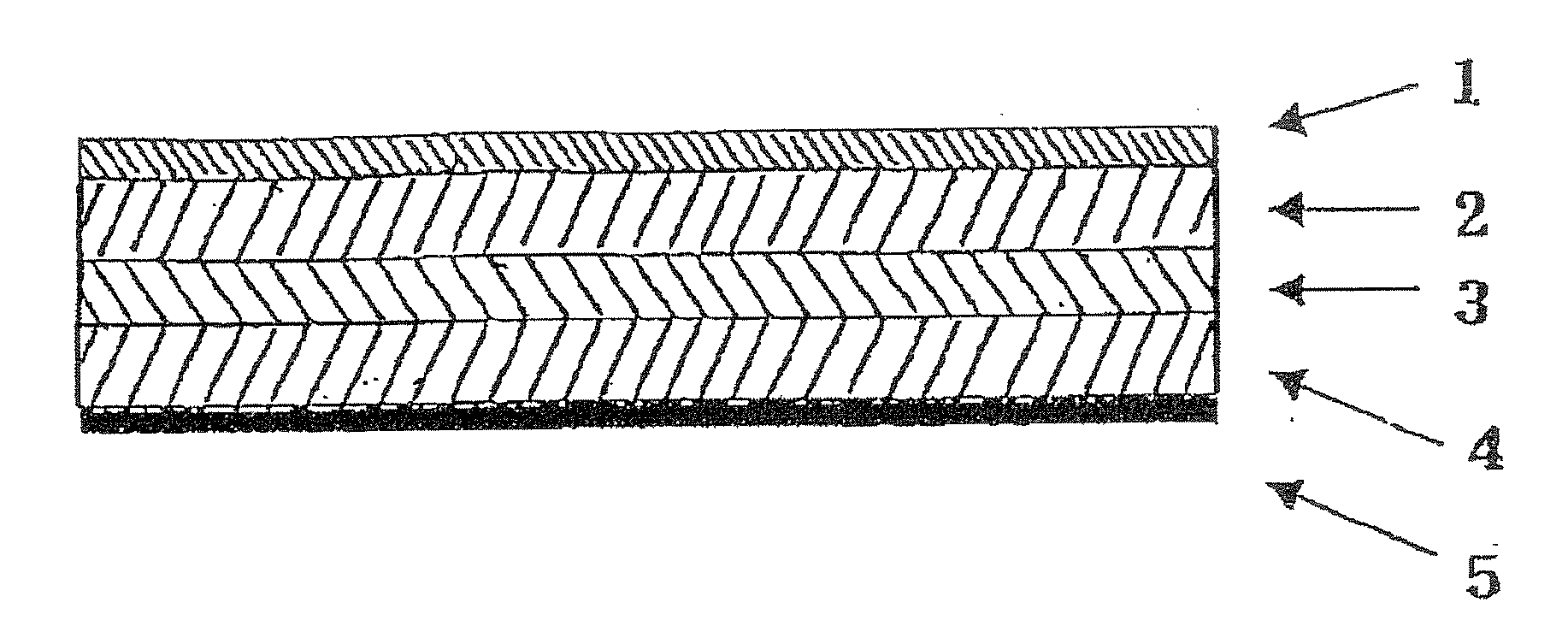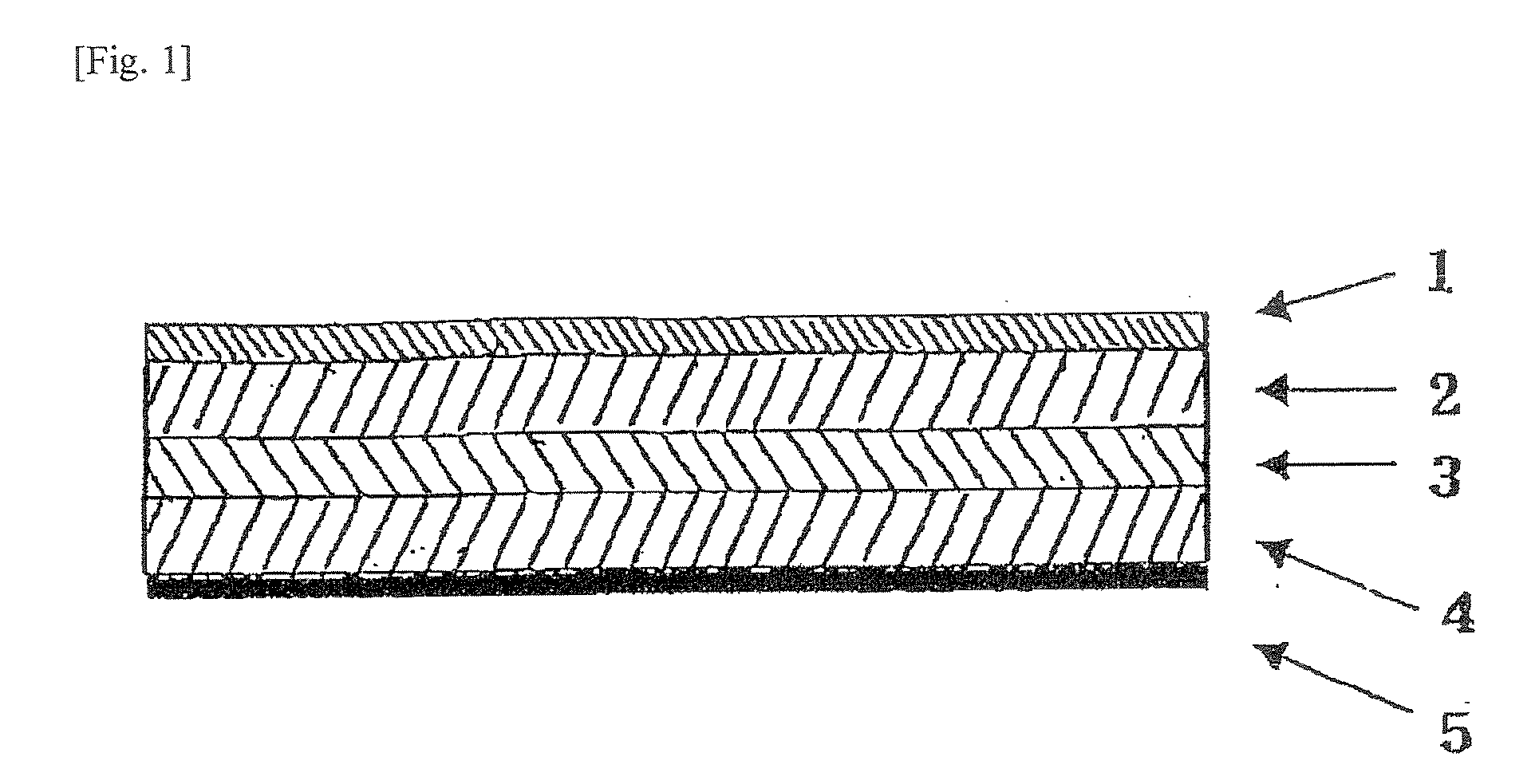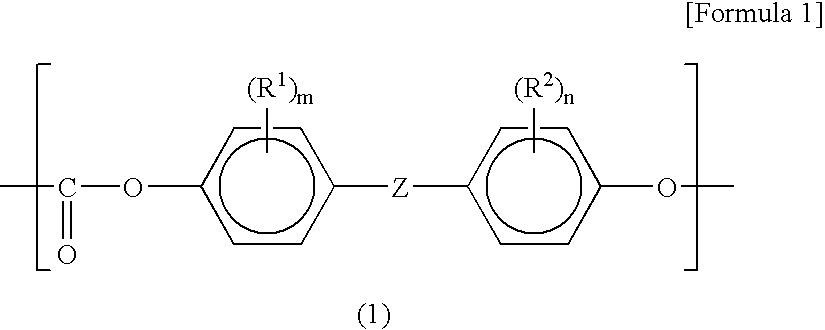Light-Shielding Highly Reflective Multilayer Sheet, and Thermoformed Body and Case Using Same
- Summary
- Abstract
- Description
- Claims
- Application Information
AI Technical Summary
Benefits of technology
Problems solved by technology
Method used
Image
Examples
production example 1
Production of PC-PDMS Copolymer
(1) Production of a PC Oligomer
[0122]A sodium hydroxide aqueous solution of bisphenol A was prepared by dissolving 60 kg of bisphenol A in 400 liters of a 5% by mass sodium hydroxide aqueous solution. Then, the sodium hydroxide aqueous solution of bisphenol A with the temperature maintained room temperature and methylene chloride were introduced at a flow rate of 138 liters / hr and 69 liters / hr, respectively, through an orifice plate into a tubular reactor having an inner diameter of 10 nm and a tube length of 10 m, and concurrently phosgene was blown in a parallel flow at a flow rate of 10.7 kg / hr to carry out reaction continuously for 3 hr. The tubular reactor used here was made of a double tube, and cooling water was passed through the jacket to maintain the discharge temperature of the reaction solution at 25° C. The pH value of the discharged solution was adjusted to 10 to 11.
[0123]By allowing the resultant reaction solution to stand, the aqueous p...
production example 2
Production of Polycarbonate-Based Resin Composition-1 (PC1)
[0131]With respect to 100 parts by mass of the total of 46% by mass of the polycarbonate-poly(dimethylsiloxane) copolymer obtained in the Production Example 1 (PC-PDMS, Mv=17,000, PDMS content=3.0% by mass), 24% by mass of bisphenol A-type linear polycarbonate 1 (produced by Idemitsu Petrochemical Co., Ltd., trade name: Tarflon FN1500, Mv=14,500) and 30% by mass of titanium oxide powder (produced by ISHIHARA SANGYO KAISHA, LTD., trade name: PF726), 1.2 parts by mass of organosiloxane (produced by Dow Corning Toray Co., Ltd., trade name: BY16-161), 0.3 part by mass of polytetrafluoroethylene (PTFE, produced by ASAHI GLASS CO., LTD. trade name: CD076) and 0.1 part by mass of triphenylphosphine (produced by Johoku Chemical Co., Ltd., trade name: JC263) were mixed. The resultant mixture was melted and kneaded in a two-axis extruder to obtain a polycarbonate-based resin composition.
production example 3
Production of Polycarbonate-Based Resin Composition-2 (PC2)
[0132]With respect to 100 parts by mass of the total of 59% by mass of the polycarbonate-polydimethylsiloxane copolymer obtained in the Production Example 1 (PC-PDMS, Mv=17,000, PDMS content=3.0% by mass), 31% by mass of bisphenol A-type linear polycarbonate 1 (produced by Idemitsu Petrochemical Co., Ltd., trade name: Tarflon FN 1500, Mv=14,500) and 10% by mass of titanium oxide powder (produced by ISHIHARA SANGYO KAISHA, LTD., trade name: PF726), 0.8 part by mass of organosiloxane (produced by Dow Corning Toray Co., Ltd., trade name: BY16-161), 0.3 part by mass of polytetrafluoroethylene (PTFE, produced by ASAHI GLASS CO., LTD. trade name: CD076) and 0.1 part by mass of triphenylphosphine (produced by Johoku Chemical Co., Ltd., trade name: JC263) were mixed. To the resultant mixture, 1 part by mass of an ultraviolet absorber (produced by Chemipro Kasei Kaisha, Ltd., trade name: Chemisorb 79) was further added, and the mixtu...
PUM
| Property | Measurement | Unit |
|---|---|---|
| Fraction | aaaaa | aaaaa |
| Fraction | aaaaa | aaaaa |
| Fraction | aaaaa | aaaaa |
Abstract
Description
Claims
Application Information
 Login to View More
Login to View More - R&D
- Intellectual Property
- Life Sciences
- Materials
- Tech Scout
- Unparalleled Data Quality
- Higher Quality Content
- 60% Fewer Hallucinations
Browse by: Latest US Patents, China's latest patents, Technical Efficacy Thesaurus, Application Domain, Technology Topic, Popular Technical Reports.
© 2025 PatSnap. All rights reserved.Legal|Privacy policy|Modern Slavery Act Transparency Statement|Sitemap|About US| Contact US: help@patsnap.com



